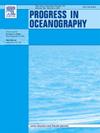来自亚洲沙尘的铁肥料驱动太平洋鲑鱼的三级生产力
IF 3.6
3区 地球科学
Q1 OCEANOGRAPHY
引用次数: 0
摘要
据推测,高常量营养素、低叶绿素海洋表面的铁富集可以增强初级生产和碳汇,最终影响地球气候系统。虽然初级生产和碳汇的增强已被反复证实,但铁在上层生产中的作用仍未得到调查,因此,我们对生态系统响应的理解是不完整的。在这个分析中,收集了古记录和现代时间序列,以验证一个扩展的假设,即铁施肥也促进了第三纪生产力。关于红鲑鱼大量返回阿拉斯加湖泊的古代用物和现代记录与气候变量有关,这些气候变量描述了含铁的亚洲粉尘的通量、其跨太平洋的运输以及它在阿拉斯加红鲑鱼觅食地海湾的沉积。这种联系表明,在大约2200年的时间里,鲑鱼种群的生产力一直受到亚洲沙尘供应的推动。来自现代观测的数据为尘铁投入、初级生产和鲑鱼丰度之间的联系提供了更直接的支持。这一分析表明,来自亚洲尘埃的铁通过自下而上的食物网控制,主要通过红鲑鱼的生产力驱动。对铁在三级生产中的作用的这种认识,为人工增加海洋生物资源提供了基础,但也产生了关于铁施肥在减缓气候变化方面的效率的问题。本文章由计算机程序翻译,如有差异,请以英文原文为准。
Iron fertilization from Asian dust drives tertiary-level productivity of Pacific salmon
Iron enrichment in high-macronutrient, low-chlorophyll surface oceans was hypothesized to enhance primary production and carbon sinks that ultimately influence the earth’s climatic system. Although the enhancement of primary production and carbon sinks has been repeatedly verified, the role of iron in upper-level production remained uninvestigated, and thus, our understanding of ecosystem responses is incomplete. In this analysis, paleorecords and modern time series are gleaned to test an extended hypothesis that tertiary-level productivity is also promoted by iron fertilization. Paleoproxies and modern records for the abundance of sockeye salmon returning to an Alaskan lake are related to climatic variables describing the flux of iron-laden Asian dust, its trans-Pacific transport, and its deposition into the iron-limited Gulf of Alaska sockeye salmon feeding ground. The linkage shows that for ∼2,200 years, the productivity of the salmon stock has been driven by this Asian dust supply. Data from modern observations provide more direct support for the linkage between dust-iron input, primary production, and salmon abundance. This analysis indicates that iron from Asian dust drives primary through to sockeye salmon productivity via bottom-up food-web control. This understanding of the role of iron in tertiary-level production provides a basis for the artificial enhancement of ocean living resources, but questions arise regarding the efficiency of iron fertilization in climate mitigation.
求助全文
通过发布文献求助,成功后即可免费获取论文全文。
去求助
来源期刊

Progress in Oceanography
地学-海洋学
CiteScore
7.20
自引率
4.90%
发文量
138
审稿时长
3 months
期刊介绍:
Progress in Oceanography publishes the longer, more comprehensive papers that most oceanographers feel are necessary, on occasion, to do justice to their work. Contributions are generally either a review of an aspect of oceanography or a treatise on an expanding oceanographic subject. The articles cover the entire spectrum of disciplines within the science of oceanography. Occasionally volumes are devoted to collections of papers and conference proceedings of exceptional interest. Essential reading for all oceanographers.
 求助内容:
求助内容: 应助结果提醒方式:
应助结果提醒方式:


